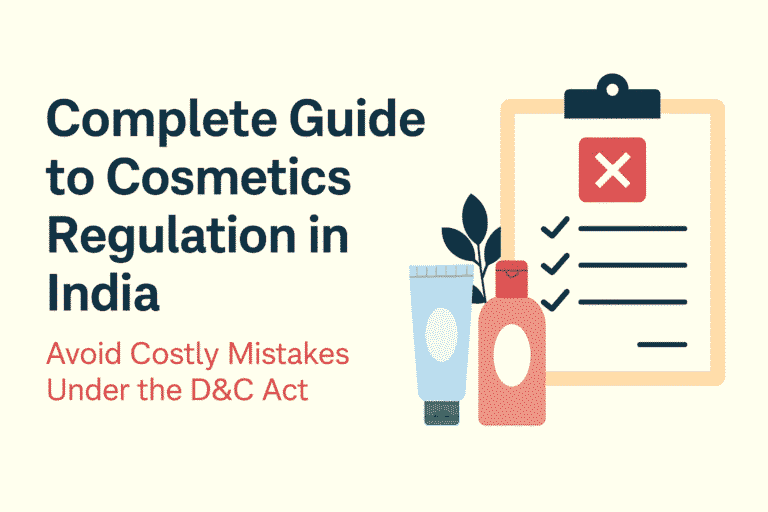The Indian cosmetic industry is growing at a rapid pace, with increasing demand for skincare, haircare, and personal hygiene products. To ensure public safety and product quality, the manufacture of cosmetics is strictly governed by the Drugs and Cosmetics Act, 1940 and Rules, 1945. Whether you’re a manufacturer, pharma student, or regulatory professional, understanding the technical requirements and legal obligations is essential.
This blog provides in-depth and updated information about the regulatory provisions for the manufacture of cosmetics in India, including licensing conditions, GMP standards, loan licenses, prohibited substances, and applicable penalties.

Table of Contents
What is a Cosmetic Under Indian Law?
As per Section 3(aaa) of the Drugs and Cosmetics Act, 1940:
“Cosmetic means any article intended to be rubbed, poured, sprinkled, or sprayed on, or introduced into, or otherwise applied to the human body or any part thereof for cleansing, beautifying, promoting attractiveness, or altering the appearance.”
Licensing Requirements for Cosmetic Manufacturing
To manufacture cosmetics in India, it is mandatory to obtain a license from the State Licensing Authority under the Drugs and Cosmetics Rules.
Forms & License Types
| Activity | Application Form | License Issued in Form |
|---|---|---|
| Fresh License for Manufacturing | Form 31 | Form 32 |
| License Renewal | Form 31-A | Form 32-A |
| Loan License (Contract Basis) | Form 31-A | Form 32-A |
Key Conditions for Obtaining a Manufacturing License
1. Premises and Infrastructure (Schedule M-II)
- Minimum area: 15–25 sq. m depending on product types.
- Proper drainage, lighting, ventilation, dust control.
- Must comply with Schedule M-II which outlines GMP for cosmetics.
2. Qualified Technical Staff
Supervision must be done by:
- A registered pharmacist (Diploma in Pharmacy), or
- A graduate in Science with Chemistry, or
- A chemical engineer with relevant experience.
3. Manufacturing Equipment
- GMP-compliant and suitable for type of cosmetic: mixers, homogenizers, packaging lines, etc.
4. In-house or Contractual Quality Control Laboratory
Must have equipment for:
- Microbial testing
- pH and viscosity analysis
- Heavy metal testing
- Stability studies
5. Documentation & Record-Keeping
- Batch Manufacturing Record (BMR)
- Standard Operating Procedures (SOPs)
- Market complaint records
- Test reports and release authorizations
Prohibited Manufacturing Activities
As per Rules 144, 145, 145D of the D&C Rules:
Use of Harmful Ingredients:
- Lead, arsenic, and mercury in amounts exceeding BIS standards.
- Mercury compounds banned in skin-lightening creams.
Use of Hexachlorophene:
- Completely prohibited in cosmetics (except in toothpaste under 0.1% concentration).
False or Misleading Claims:
Unproven therapeutic claims such as “anti-aging” or “acne cure” can lead to misbranding.
Animal Testing Ban:
Import, manufacture, or sale of cosmetics tested on animals is strictly prohibited in India since 2014 (Rule 135B).
Loan License – Contract Manufacturing for Cosmetics
What is a Loan License?
A Loan License is granted to a person who wishes to manufacture cosmetics using another company’s approved manufacturing facility.
Key Conditions:
- The contract manufacturer must have a valid Form 32 license.
- A legal agreement must exist between both parties.
- The license holder is responsible for ensuring GMP, documentation, and regulatory compliance.
Good Manufacturing Practices (GMP) – Schedule M-II
The manufacture of cosmetics must align with Schedule M-II standards under the D&C Rules:
Core GMP Requirements:
- Clean & hygienic manufacturing area.
- Purified water system (RO + UV).
- Environmental monitoring for microbial contamination.
- Trained personnel in gowning, sanitation, and material handling.
- Equipment validation and calibration.
- SOPs for all critical processes.
BIS Specifications:
- IS 4707 Part I: Approved colorants
- IS 4707 Part II: Approved preservatives and UV filters
- IS 6608: General requirements for cosmetic products.
Labeling Requirements for Manufactured Cosmetics
Even at the manufacturing stage, cosmetic products must be labeled according to Rule 148 of the D&C Rules:
Mandatory Label Elements:
- Name of the cosmetic
- Manufacturer’s name and address
- Batch number
- Manufacturing and expiry date
- Net quantity
- Direction for use & warnings
- List of ingredients (for packs above 60g/60ml)
- “FOR EXTERNAL USE ONLY” (where applicable)
Offences and Penalties Under the Act
Violations of the regulatory provisions are punishable under Section 27A and 33-I:
| Offense | Penalty |
|---|---|
| Manufacture without license | Upto 1 year imprisonment or fine or both |
| Manufacturing misbranded cosmetics | Fine and/or imprisonment |
| Sale of spurious or adulterated products | 3 years to life imprisonment + up to ₹1 lakh fine |
| Violation of license terms | License cancellation, suspension, or prosecution |
Record Keeping Mandates
License holders must maintain the following:
- Batch Manufacturing & Packaging Records
- Market Complaint File
- Product Recall Procedures
- Distribution Records
- Test Reports
- Shelf-life Data
Conclusion
The regulatory framework for manufacturing cosmetics in India ensures product safety, quality, and consumer transparency. From licensing to GMP compliance, manufacturers must adhere to stringent legal provisions under the Drugs and Cosmetics Act, 1940 and Rules, 1945.
For M.Pharm students, regulatory professionals, and entrepreneurs, staying updated on these guidelines is crucial to ensure lawful and successful cosmetic product launches in the Indian market.

Pingback: [UNIT – I] – “Teaching today, transforming tomorrow — one formulation at a time.”